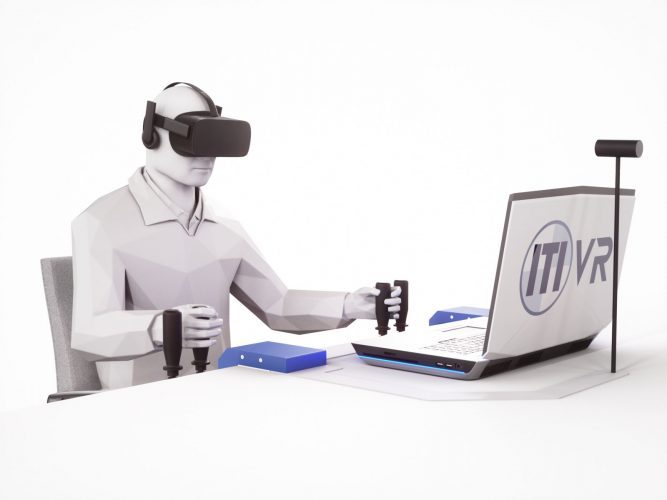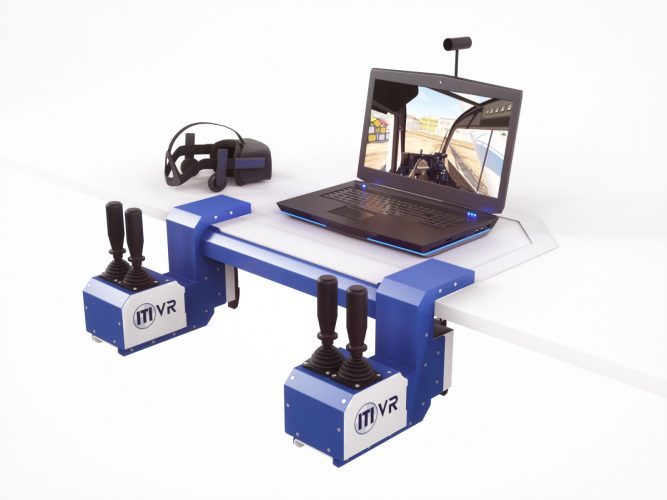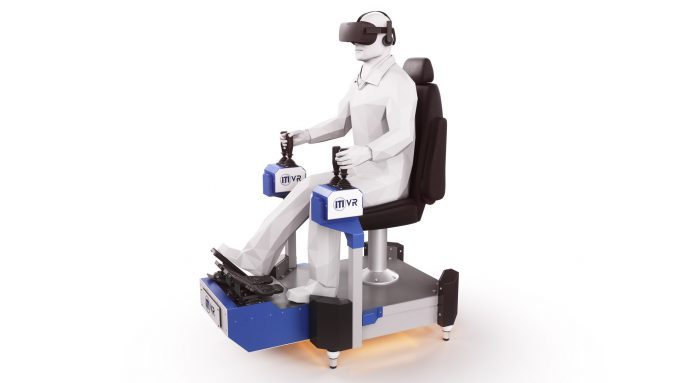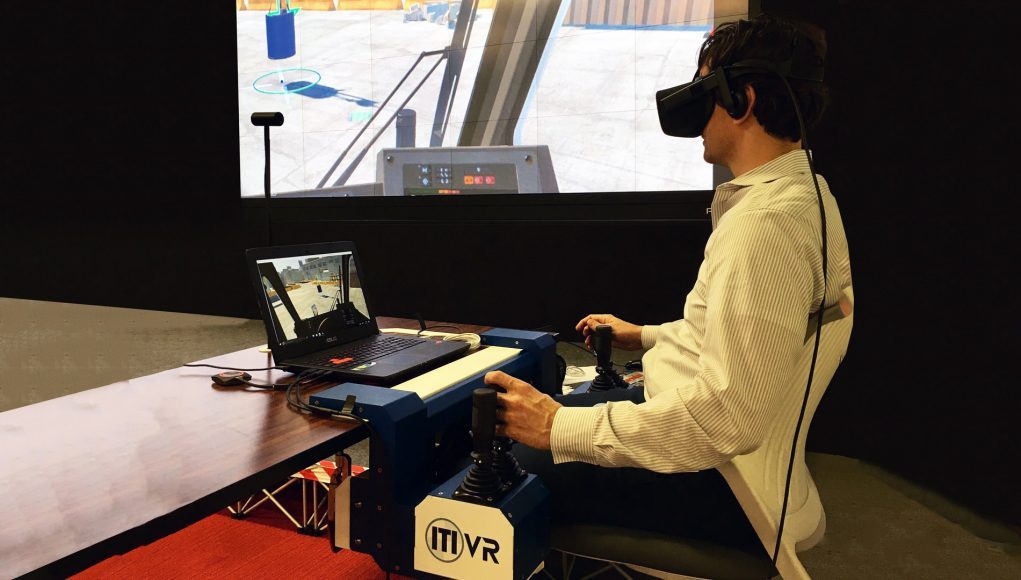Industrial Training International is readying their VR Mobile Crane Simulator for the March ConExpo Event in Las Vegas. The simulator uses an Oculus Rift headset in combination with a modular rig, in order to significantly reduce the costs of training, compared to both real-world and older simulator solutions.
Last September, Industrial Training International VR (ITI VR) announced the development of a ‘VR Mobile Crane Simulator’ (in this case, the term ‘mobile’ refers to the type of crane, rather than VR optimised for a smartphone). Created in partnership with Canadian developer Serious Labs Inc, the system is on schedule for a March launch, having run a beta program since October.
The simulator, which uses an Oculus Rift headset, comes in two forms – ‘Desktop’ and ‘Motion Base’. They use the same modular control system, including five joystick modules for the user to swap out to match the model of crane they are operating. The layout is mapped accurately to the real crane ergonomics to retain immersion, with foot pedals coming soon. The modular design allows for custom features to be added (such as force-feedback joysticks) if required. The Motion Base version uses the same joystick layout, but instead of being clamped to a table, it is a standalone unit, adding a chair with four actuators in the base, creating a convincing sense of movement. The development models are seen in ITI’s ‘First Look’ video (above) – the Xbox One controller shown was a temporary option while the desktop hardware was being fabricated.
ITI VR Product Manager Caleb Steinborn explains the effectiveness of the Motion Base, which is also used for their Aerial Work Platform simulator – another VR development from Serious Labs with equipment rental giant, United Rentals. “I have seen many people experience fairly extreme fear of heights while being hoisted into the air with the AWP simulator, all the while having never left the ground. The realism is truly an experience unlike anything else.”
 There is also a small training benefit from sensing some of the forces acting on the crane, and in the case of the Aerial Work Platform, the vestibular feedback created by the actuators minimises simulator sickness. For the crane sim, the accelerations are lower, so nausea isn’t an issue, but it can reproduce an “extremely powerful” feeling of tipping a 100-tonne crane.
There is also a small training benefit from sensing some of the forces acting on the crane, and in the case of the Aerial Work Platform, the vestibular feedback created by the actuators minimises simulator sickness. For the crane sim, the accelerations are lower, so nausea isn’t an issue, but it can reproduce an “extremely powerful” feeling of tipping a 100-tonne crane.
The Oculus Rift headset was selected by Serious Labs as they believe it to be the more comfortable and portable solution at this stage, however the sim supports OpenVR, and therefore could work on the HTC Vive, and other headsets. “Currently we use the Oculus Rift simply because at the time the developers felt like it was the stronger headset of the two. As the technology emerges, we will keep up with latest and greatest.”
 Founded in 1986, ITI is a world leader in crane and rigging training and consulting; they are relied on by multiple industries such as mining, construction, and energy. Having dismissed older simulator options due to their high costs, impracticality, lack of depth perception and realism, ITI is now introducing a new generation of simulators that utilize VR headsets to create a far more compact, affordable option. Legacy solutions typically cost well over $100,000—ITI’s simulator will be a fraction of the price.
Founded in 1986, ITI is a world leader in crane and rigging training and consulting; they are relied on by multiple industries such as mining, construction, and energy. Having dismissed older simulator options due to their high costs, impracticality, lack of depth perception and realism, ITI is now introducing a new generation of simulators that utilize VR headsets to create a far more compact, affordable option. Legacy solutions typically cost well over $100,000—ITI’s simulator will be a fraction of the price.
The sheer scale of a legacy crane sim (ranging from the size of an actual crane cab to a semi-truck trailer) is the other major hurdle, with the shipping, setup and commissioning alone typically costing more than the entire purchase price of the ITI desktop sim. Having trained operators for more than three decades, ITI has received plenty of feedback from the industry, lamenting the high cost and low portability of legacy solutions, according to Caleb. “Most operators are not physically close to a simulator installation, so even when simulators are owned by the companies in question they are often underused.”
Offering the hardware at cost and charging a subscription for the software means that, in addition to the low cost of entry, subscribers gain access to the full training ecosystem as it becomes available, which will include new content (such as new crane models/types and new environments), new features (such as training events, networked “multiplayer,” enabling multi-crane lifts as well as multi-user lifts performing different functions), and future courses utilizing hand controls to train rigging, signaling, inspection, crane assembly/disassembly, and more.
 ITI provides real-world hands-on training courses at seven training centres in the United States and Canada, and at client locations around the world. The mobile crane operator courses are capped at 12 students to ensure decent seat time in the crane for each trainee, and attention from the instructor. For all the advantages of live, instructor-led training, there are limitations including seat time, available lift scenarios, and the ability to replicate rare challenges; the new VR solution can provide practically unlimited seat time, and can cover topics and events that aren’t easily reproduced (such as dealing with inclement weather and system failures) in real life. The cost benefits can be enormous, particularly when you consider the equivalent real-world worksite preparation and dealing with potential damages. It’s possible for a job that involves a single critical lift to be billed at a million dollars or more.
ITI provides real-world hands-on training courses at seven training centres in the United States and Canada, and at client locations around the world. The mobile crane operator courses are capped at 12 students to ensure decent seat time in the crane for each trainee, and attention from the instructor. For all the advantages of live, instructor-led training, there are limitations including seat time, available lift scenarios, and the ability to replicate rare challenges; the new VR solution can provide practically unlimited seat time, and can cover topics and events that aren’t easily reproduced (such as dealing with inclement weather and system failures) in real life. The cost benefits can be enormous, particularly when you consider the equivalent real-world worksite preparation and dealing with potential damages. It’s possible for a job that involves a single critical lift to be billed at a million dollars or more.
The simulation is realistic enough to provide all the operational practice needed to pass a practical exam from the NCCCO, and can serve as the focal point or a supplement to traditional training. “Our goal is to provide every possible training solution option to those who are in need”, says Caleb. “Sometimes that training solution will be a live, instructor-led course, and sometimes it is going to be a VR Simulator. It is our job to ensure that the quality of every option is of the highest caliber, and our VR Mobile Crane simulator is only just beginning.”







